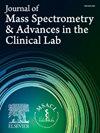Development and validation of a highly-sensitive, quantitative LC-MS/MS assay to evaluate plasma oxytocin
IF 3.4
4区 医学
Q2 MEDICAL LABORATORY TECHNOLOGY
Journal of Mass Spectrometry and Advances in the Clinical Lab
Pub Date : 2025-02-22
DOI:10.1016/j.jmsacl.2025.02.002
引用次数: 0
Abstract
Introduction
Oxytocin is a 9-amino acid peptide that serves as neuromodulator in the human central nervous system. This peptide is implicated in the regulation of diverse behaviors and plays a significant role in positive social interaction. Currently, oxytocin levels are measured using immunoassays. However, these methods have several limitations that can lead to false results and erroneous interpretation. Given the remarkably low endogenous level of oxytocin in human plasma (low ng/L levels), we developed and rigorously validated a novel and highly sensitive LC-MS/MS method for oxytocin quantification in plasma.
Methods
Oxytocin was initially extracted using solid-phase extraction with an Oasis HLB 30 mg plate and then subjected to LC-MS/MS analysis. PBS-0.1 % BSA served as surrogate matrix for the preparation of validation samples and the calibration curve, ensuring no endogenous interference. The validation design followed the Clinical Laboratory Standards Institute guidelines. Precision, accuracy, and measurement uncertainty were determined using single-nested analysis of variance and e.noval software.
Results
A lower limit of quantification of 1 ng/L was achieved. The method was validated for oxytocin concentrations ranging from 1 ng/L to 75 ng/L, with precision (coefficient of variation) below 10 %, accuracy ranging from 94 % to 108 %, and measurement uncertainty below 15 %.
Conclusion
In this work, we developed and validated a highly sensitive LC-MS/MS method for the quantification of oxytocin in plasma. Our novel methodology is well-suited for clinical applications.

一种高灵敏度、定量LC-MS/MS检测血浆催产素的方法的开发和验证
催产素是一种9个氨基酸的肽,在人类中枢神经系统中起神经调节剂的作用。这种肽与多种行为的调节有关,在积极的社会互动中起着重要作用。目前,催产素水平是通过免疫分析法来测量的。然而,这些方法有一些局限性,可能导致错误的结果和错误的解释。鉴于人血浆中催产素的内源性水平非常低(低ng/L水平),我们开发并严格验证了一种新的、高灵敏度的LC-MS/MS定量血浆中催产素的方法。方法采用Oasis HLB 30 mg平板固相萃取法提取催产素,然后进行LC-MS/MS分析。以pbs - 0.1%牛血清白蛋白为替代基质制备验证样品和校准曲线,确保无内源干扰。验证设计遵循临床实验室标准协会的指南。精密度、准确度和测量不确定度采用单套方差分析和e.noval软件确定。结果达到了1 ng/L的定量下限。该方法在1 ~ 75 ng/L的浓度范围内验证,精密度(变异系数)在10%以下,准确度在94% ~ 108%之间,测量不确定度在15%以下。结论建立并验证了血浆中催产素的高灵敏度LC-MS/MS定量方法。我们的新方法非常适合临床应用。
本文章由计算机程序翻译,如有差异,请以英文原文为准。
求助全文
约1分钟内获得全文
求助全文
来源期刊

Journal of Mass Spectrometry and Advances in the Clinical Lab
Health Professions-Medical Laboratory Technology
CiteScore
4.30
自引率
18.20%
发文量
41
审稿时长
81 days
 求助内容:
求助内容: 应助结果提醒方式:
应助结果提醒方式:


